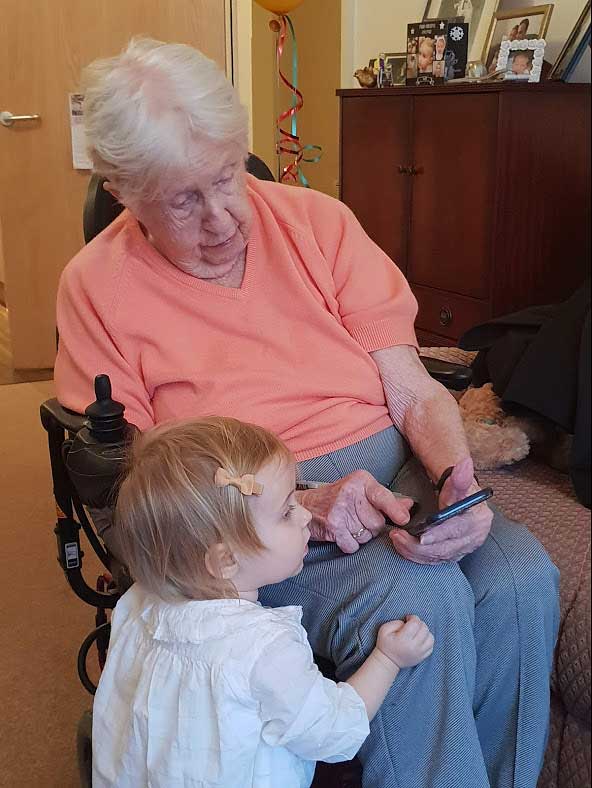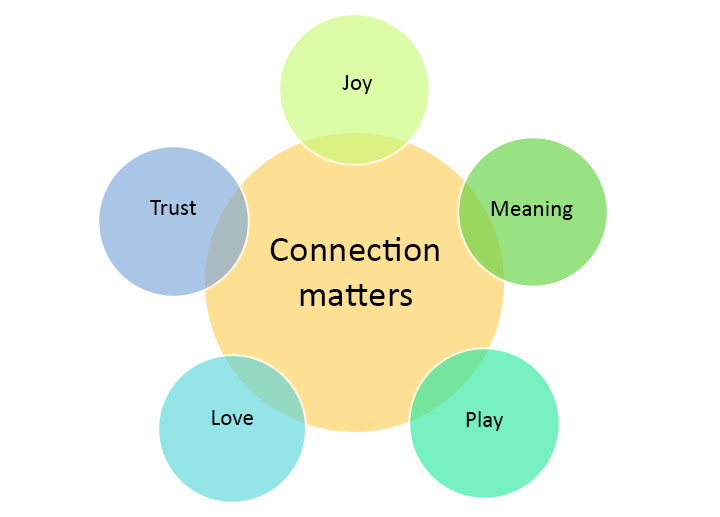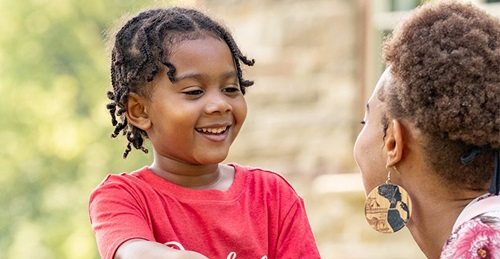Learning from intergenerational practice
A partnership of equals
| November 2021Pixie sits happily with Irene to enjoy lunch together. They chatter and Irene helps Pixie with her food, encouraging her to use her spoon carefully. They are in their own world, absorbed by each other and beautifully attuned – a partnership of equals. Pixie is 14 months old and Irene 97 years young, born nearly a century apart.
The connection between them is palpable and wonderful to observe. The flow of language and babble goes backwards and forwards respectfully with each taking a turn. Without being aware, Irene is modelling the serve and return nature of effective dialogue. She listens to Pixie with great sensitivity, responding to the changing nature of her needs quietly and purposefully. Pixie clearly feels safe knowing her needs will be met with love. Secure in the flow of the moment, both are gaining so much from each other through the simple act of sharing food.

Since its inception as a charity in 2019, Ready Generations has been working to connect people of all ages through everyday opportunities which demonstrate an understanding of the importance of the lived experience. This means planning carefully to ensure experiences are respectful, provide choices and allow all involved, whatever their age, to gain from both sharing knowledge and attributing personal meaning to a particular activity or event.
Intergenerational nursery – a ground-breaking project
A major project for the charity is the integration of a purpose-built intergenerational nursery into the heart of a new care village in the city of Chester, England. The thinking behind the model has taken over three years and involved the pooling of expertise between early years and older people’s care leaders. Ready Generations has been working in partnership with Belong Ltd who have provided high quality residential living and care services across the North West of England for many years. The nursery is now nearing completion with an anticipated opening date of February 2022.
A central consideration has been to define the culture for this new mixed-age community and establish its way of living and being. This is where understanding of the lived experience has featured strongly in the development of thinking around both shared habits and spaces. Five design principles have been used to test all decisions as the project has moved through the design, planning, implementation and actualisation phases. See the chart in the appendix to find out about these design principles and how they can be put into effect.

Things to think about when bringing generations together on an intergenerational journey
There are many ways for settings to engage, learn and get involved in intergenerational work. All require careful planning around inclusion, diversity and integration.
Here are a few important things to think about from what Ready Generations has learned so far:
- Be intentional in building sustained relationships that develop over time rather than one off sessions or short term projects.
- Involve parents and families from the start to help them to understand the benefits and positive impact of intergenerational activity for both age groups.
- Allow children and older people to spend time getting to know each other. Prioritise opportunities for talk and dialogue. Let conversations flow naturally and try not to interfere!
- Think carefully about the set-up of the physical space to ensure safe engagement and management of risks e.g. infection control, slip and trip hazards, uncluttered walking routes, adult wheelchair and walking frame access.
- Consider comfort and the availability of appropriate and attractive seating and tables for older people who may have restricted mobility and movement.
- Think sensitively about resources to make sure they are appropriate for older people e.g. not perceived as childish by them.
- Air temperature and ventilation – many older people feel the cold much more than children, particularly when outdoors, so length of activity is important in colder conditions e.g. have additional blankets available for older people who are less mobile.
- Noise levels and acoustics matter – a calm and quiet environment reduces levels of anxiety for both age groups and increases participation and involvement particularly for children and older people with hearing impairment. So, it is important to think about flooring, furniture and defined spaces for noisier activities.
- Keep things simple and don’t rush – both children and older people can become confused and anxious if they feel pressured and rushed. Keep planning simple and don’t try to do too much in any one session. Let the children and older people set the pace!
- Design from the inside out rather than the outside in to ensure the needs of children and older people are kept at the centre of all thinking – see the diagram below.

Finally, let’s return to Pixie and Irene. They have become firm friends, meeting regularly and building a close bond. Irene says she feels less alone knowing Pixie and her family are around. She also feels happy that she is able to help and contribute to Pixie’s development and learning. Irene constantly uses the same words to describe the importance to her of maintaining a connection with young children. Ready Generations have now incorporated these words into their intergenerational training sessions:

Perhaps the most heart-warming comment from Irene in describing her relationship with Pixie is:
“We are pals and I like it that way. We are important to each other and age just doesn’t matter. We have a lot in common. We both like to play!”
Thank you to Pixie and Irene for sharing their story. The future for intergenerational practice is certainly bright!

Ready Generations

Twitter @readygen
Email: Sue Egersdorff (Charity Founder) at sue@readygenerations.co.uk

Appendix
Five design principles
Five design principles have been used to test all decisions as the project has moved through the design, planning, implementation and actualisation phases for the new care village in Chester. The nursery is now nearing completion with an anticipated opening date of February 2022.
| Top five design principles | How they have been implemented | |
|---|---|---|
| 1. | A shared vision and set of operating values established early and owned by everyone. i.e. I feel safe here and can be my true self. | Regular scheduled meetings with architects and planners have included older people and children alongside the leaders of both organisations as equal partners. |
| 2. | Central importance of belonging and owning the space i.e. This is my space and I am welcomed here. | The physical spaces both in and outdoors have been carefully and thoughtfully aligned and tested against the vision and values with a strong focus on sensory experience and active lifestyles. |
| 3. | Personalisation and maximum independence planned for and prioritised for both age groups i.e. I am understood, care is responsive to my unique needs and always dignified. | Both age groups have been listened to, their views respected and design changes made to accommodate their ideas and to meet diverse needs. Dignified and responsive human design has featured strongly at every stage. |
| 4. | Professional understanding and collaborative training built into the model to achieve high levels of consistency and sustainability in the quality of practice i.e. for both children and older people i.e. I am an active practitioner in a learning community that is ambitious and wants the very best for everyone. | The importance of taking time to build a shared consensus around all aspects of intergenerational pedagogy has been recognised and built into shared training for everyone involved. |
| 5. | Environmental spaces are flexible, sensory and responsive for all ages with barriers to engagement removed as far as possible i.e. I enjoy the environment and feel settled and secure. |
People led spaces have been a primary consideration from the outset. This has included a focus on: • Safeguarding and health and safety • Risk management and infection control • Biophilic design i.e. seeking to connect with the human need to affiliate with nature using all the senses • Physical movement |
Further reading
Dennis, Kingsley L. (2014). The Phoenix Generation. Watkins Publishing
George, Lorraine (2019). Growing Together. Yellow Door
Hodson, Murray & Terry White (2020). Planning Learning Spaces. Laurence King Publishing
Kernan, Margaret & Giulia Cortellesi (2019). Intergenerational Learning in Practice. Routledge






